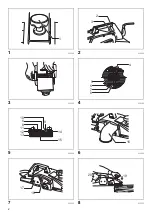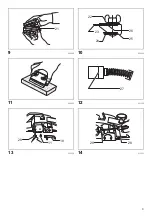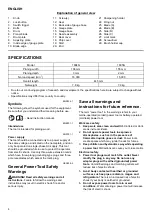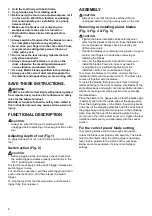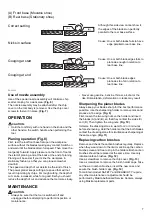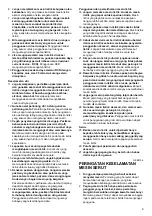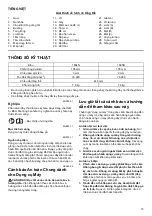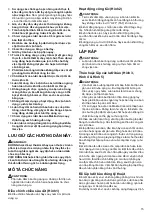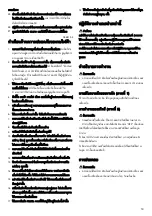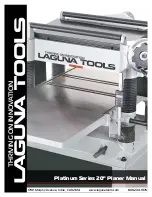
6
8.
Hold the tool firmly with both hands.
9.
Keep hands away from rotating parts.
10.
Before using the tool on an actual workpiece, let it
run for a while. Watch for vibration or wobbling
that could indicate poor installation or a poorly
balanced blade.
11.
Make sure the blade is not contacting the
workpiece before the switch is turned on.
12.
Wait until the blade attains full speed before
cutting.
13.
Always switch off and wait for the blades to come
to a complete stop before any adjusting.
14.
Never stick your finger into the chip chute. Chute
may jam when cutting damp wood. Clean out
chips with a stick.
15.
Do not leave the tool running. Operate the tool
only when hand-held.
16.
Always change both blades or covers on the
drum, otherwise the resulting imbalance will
cause vibration and shorten tool life.
17.
Use only Makita blades specified in this manual.
18.
Always use the correct dust mask/respirator for
the material and application you are working with.
SAVE THESE INSTRUCTIONS.
WARNING:
DO NOT let comfort or familiarity with product (gained
from repeated use) replace strict adherence to safety
rules for the subject product.
MISUSE or failure to follow the safety rules stated in
this instruction manual may cause serious personal
injury.
FUNCTIONAL DESCRIPTION
CAUTION:
• Always be sure that the tool is switched off and
unplugged before adjusting or checking function on the
tool.
Adjusting depth of cut (Fig. 1)
To adjust the depth of cut, turn the knob on the front of the
tool.
Switch action (Fig. 2)
CAUTION:
• Before plugging in the tool, always check to see that
the switch trigger actuates properly and returns to the
“OFF” position when released.
To start the tool, simply pull the switch trigger. Release the
switch trigger to stop.
For continuous operation, pull the switch trigger and then
push in the lock button, and then release the switch
trigger.
To stop the tool from the locked position, pull the switch
trigger fully, then release it.
ASSEMBLY
CAUTION:
• Always be sure that the tool is switched off and
unplugged before carrying out any work on the tool.
Removing or installing planer blades
(Fig. 3, Fig. 4 & Fig. 5)
CAUTION:
• Tighten the blade installation bolts carefully when
attaching the blades to the tool. A loose installation bolt
can be dangerous. Always check to see they are
tightened securely.
• Handle the blades very carefully. Use gloves or rags to
protect your fingers or hands when removing or
installing the blades.
• Use only the Makita wrench provided to remove or
install the blades. Failure to do so may result in
overtightening or insufficient tightening of the
installation bolts. This could cause an injury.
To remove the blades on the drum, unscrew the four
installation bolts with the socket wrench. The drum plate
comes off together with the blades.
To install the blades, first clean out all chips or foreign
matter adhering to the drum or blades. Use blades of the
same dimensions and weight, or drum oscillation/vibration
will result, causing poor planing action and, eventually,
tool breakdown.
Place the blade on the gauge base so that the blade edge
is perfectly flush with the inside edge of the gauge plate.
Place the adjusting plate on the blade, then simply press
in the heel of the adjusting plate flush with the back side of
the gauge base and tighten two screws on the adjusting
plate. Now slip the heel of the adjusting plate into the
drum groove, then fit the drum cover on it. Tighten the four
installation bolts evenly and alternately with the socket
wrench.
For the correct planer blade setting
Your planing surface will end up rough and uneven,
unless the blade is set properly and securely. The blade
must be mounted so that the cutting edge is absolutely
level, that is, parallel to the surface of the rear base.
Below are some examples of proper and improper
settings.


